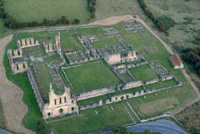 |
 |
 |
 |
 |
 |
 |
|
Byland Abbey: History
Byland Abbey: Buildings
|
The precinct The medieval precinct at Byland covered about 110 acres. It was enclosed by a perimeter wall and although little of this now survives, its layout can be established from visible earthworks. The church and claustral area stood at the heart of the precinct. Here, they were sheltered from the noise and activity of the outer and inner courts, where industrial and domestic work was carried out, where guests were accommodated and alms distributed. This was once a vast and busy hive of industry, yet all that remains standing of the inner and outer courts are remnants of the inner gatehouse. The Cistercians were concerned to establish self-sufficient communities, and the monastic precinct included ponds, pastures and orchards. A notable feature of the Byland site is the earthworks of three large ponds to the north of the church, which supplied the community with water, drainage and power. The development of the site at New Byland began in the 1150s, when the community was still at Stocking. According to the foundation history of the abbey, the site was drained, woodland was cleared and building commenced to prepare the site for monastic occupation. When the community eventually relocated here in 1177, much of the essential building would have been complete and most of the twelfth-century structures served the community throughout the Middle Ages. There were, of course, repairs and renovations, and the infirmary building was completely reconstructed in the late fourteenth century. |
